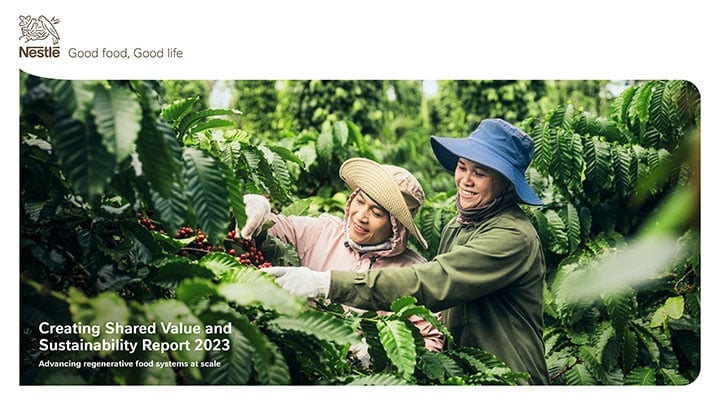Regenerative agriculture

Our Net Zero Roadmap shows that nearly two-thirds of our greenhouse gas emissions come from agriculture, so addressing these emissions is essential. One of the most important things we are doing is introducing the concept of regenerative agriculture – an initiative with incredible potential for helping address climate change while supporting communities and protecting, preserving and restoring natural resources.
Advancing regenerative food systems at scale
What is regenerative agriculture?
Regenerative agriculture is an approach to farming that aims to improve soil health and soil fertility – as well as protecting water resources and biodiversity. Restoring soil health helps capture increased levels of carbon from the atmosphere in soils and plant biomass. Healthier soils are also more resilient to the impacts of climate change and can increase productivity of crops, helping improve farmers’ livelihoods and enhancing food security.
The main pillars of regenerative agriculture
-
Biodiversity, collective & landscape actions We aim to safeguard and increase biodiversity above and below the ground. Plant life can be enhanced with more diversified crops, intercropping or planting cover crops between harvests, while encouraging more abundant animal life – from microbes to fungi, invertebrates, insects and bird life – can contribute to improved soil nutrient cycles, pollination, fertility and productivity.
Ecosystems that exist in this kind of natural equilibrium can also enhance farmers’ livelihoods and improve their resilience to climate change. For example, we aim to plant 200 million trees by 2030 in the farms and landscapes we source from, such as shade and fruit trees that provide cocoa plants with protection from the elements.
-
Water security and quality Protecting the quality of natural waters and improved stewarding of scarce water resources is essential to regeneration. We recognize the need to play our part in helping to protect, restore and renew water sources: at Nestlé Waters, our bottled-water business; throughout our agricultural supply chain and production operations; and in the communities where Nestlé has an impact.
A more strategic approach to irrigation – from sprinkler, to drip and sub-service irrigation – minimizes water evaporation compared to surface irrigation. Digital technology is also helping farms understand when land requires water, which can prevent over-use.
We also aim to reduce chemical farm inputs and optimize organic fertilization and biological pest control to reduce run-off.
-
Soil health We are helping to scale up farming practices that help protect soil health and increase soil organic matter by launching regenerative agriculture initiatives through our Farmer Connect program, which works closely with more than 500 000 farmers and 150 000 suppliers as well as local communities.
Initiatives include crop rotation, mulching, organic fertilizers and minimizing tillage. Organically ‘rich’ soils are more productive, maintain the integrity of land against soil erosion, retain more water and potentially store significant amounts of carbon.
-
Diverse cropping systems & livestock integration We aim to integrate livestock and optimize grazing in farming systems when feasible and relevant.
Regenerative agriculture is also at the heart of our efforts to help turn dairy into a net zero industry. Our work includes using silvopasture – where trees are introduced into areas used for livestock grazing – alongside mixed farming of livestock and crops, cover crops to protect soil and improved manure management, known as agroforestry.
Benefits include protection (for plant and animal life) from sun and wind, organic fertilization, improved water management and habitats conducive to other species like insects and birdlife. These approaches can also provide additional sources of farm income.
-
Collective & landscape actions Regenerative agriculture practices can look beyond individual farms to entire landscapes to protect endangered natural resources by, for example, regulating the use of common land, regional reforestation projects, protection of shared water resources and the creation of green ‘corridors’ aimed at fostering biodiversity.
The benefits can be felt not just by farmers, but entire communities in terms of welfare, profitability and reduced emissions.
Regenerative agriculture at Nestlé
We know that regenerative agriculture (pdf, 1MB) plays a critical role in improving soil health, restoring water cycles and increasing biodiversity. These outcomes form the foundation of sustainable food systems and contribute to achieving our ambitious climate targets. This is why Nestlé is investing CHF 1.2 billion by 2025 to spark regenerative agriculture across our supply chain.
In 2022, we developed the Nestlé Regenerative Agriculture Framework, guided by agro-ecological principles and practices. It is a holistic model that considers healthy, organically rich soil as a nexus to protect and restore land.
Our strategy begins with pilot studies at farms to validate new technologies and nature-based solutions. As pilots prove successful, we expand into reference farms of ‘agripreneurs’, or entrepreneurial farmers, in different countries and regions, as soils and climate requirements differ. From reference farms we aim to scale the approach to the larger agripreneur community, helping to further advance and improve their business models. We plan to roll this approach out at scale through our Farmer Connect program.
We are also encouraging industry alignment on common frameworks and metrics for regenerative agriculture.
A just transition
Regenerative food systems put people at the center, supporting solutions that are right for their regions and crops. This is why our 700+ sourcing specialists and more than 5500 support staff are assisting with the transition. The aim is to provide resilient and fair livelihoods and dignified work that enable people across the world to support themselves and their families.
The path to achieving more regenerative agriculture systems is a long-term journey. This is why we continue to help farmers by offering investment, rewarding good practices and offering technical and scientific guidance. This, together with the respect and promotion of human rights, will contribute to a just transition to regenerative food systems.
We're working hard to support farmers through the transition to a regenerative food system, by:
- Protecting and promoting human rights
- Providing state-of-the-art science and technical assistance
- Offering investment support
- Paying premiums for regenerative agriculture goods
Our income accelerator program for cocoa farmers and pilot financial support scheme for coffee farmers in Mexico, Côte d’Ivoire and Indonesia are good examples.

The focus is on educating and training suppliers and ramping up initiatives. It’s all part of our determination to get regenerative agriculture moving in the right direction.


